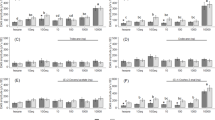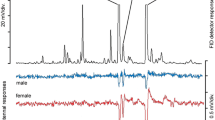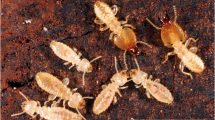Abstract
The eusocial Acacia gall-inducing thrips Kladothrips intermedius (Thysanoptera: Phlaeothripinae) secretes defensive anal droplets when threatened. In addition to harmful substances, droplets of other thysanopteran species are known to contain semiochemicals such as alarm pheromones and/or repellents against enemies. Both Kl. intermedius larval stages and adult castes (soldiers and dispersers) produce anal droplets. In addition, a recent study has shown that soldier droplets may contain an alarm pheromone. Using multiple sampling methods (extraction in solvent, solid phase microextraction and direct injection), we analyzed the content of adults and second instar larvae anal droplets by gas chromatography coupled to mass spectrometry. Anal droplets comprised of a set of saturated and monounsaturated short-chain fatty acids, including three compounds with a terminal double bond (7-octenoic acid, 8-nonenoic acid and 9-decenoic acid). The latter are here reported for the first time in an insect species. In addition, putative unsaturated wax esters similar to those found in the secretion of other social insects were also detected in droplets. In order to investigate the physiological activity of the acids, single sensillum recordings were performed on adult Kl. intermedius as well as on adults of its kleptoparasite, Koptothrips dyskritus, targeting olfactory receptor neurons in the antennal sensilla basiconica. While olfactory perception of the acids in these species cannot be completely excluded, our analyses indicate that sensilla basiconica are not strongly sensitive to these droplet compounds.





Similar content being viewed by others
References
Ali MF, Billen JPJ, Jackson BD, Morgan ED (1989) The Dufour gland contents of 3 species of Euro-African Messor ants and a comparison with those of North-American Pogonomyrmex (Hymenoptera, Formicidae). Biochem Syst Ecol 17:469–477. doi:10.1016/0305-1978(89)90026-4
Attygalle AB, Vostrowsky O, Bestmann HJ, Morgan ED (1987) New chemicals from the Dufour gland of the formicine ant Lasius niger (Hymenoptera: Formicidae). Insect Biochem 17:219–225. doi:10.1016/0020-1790(87)90163-6
Blum MS, Fales HM, Jones TH, Rinderer TE, Tucker KW (1983) Caste-specific esters derived from the queen honey bee sting apparatus. Comp Biochem Physiol B-Biochem Mol Biol 75:237–238. doi:10.1016/0305-0491(83)90320-6
Buser HR, Arn H, Guerin P, Rauscher S (1983) Determination of double-bond position in monounsaturated acetates by mass-spectrometry of dimethyl disulfide adducts. Anal Chem 55:818–822. doi:10.1021/ac00257a003
Chapman TW, Crespi BJ, Perry SP (2008) The evolutionary ecology of eusociality in Australian gall thrips: A ‘model clades’ approach. In: Korb J, Heinze J (eds) Ecology of social evolution, 1st edn. Springer-Verlag, Berlin, pp 57–83
Crespi BJ (1992) Eusociality in Australian gall thrips. Nature 359:724–726. doi:10.1038/359724a0
Crespi BJ, Abbot P (1999) The behavioral ecology and evolution of kleptoparasitism in Australian gall thrips. Fla Entomol 82:147–164. doi:10.2307/3496568
Crespi BJ, Morris DC, Mound LA (2004) Evolution of ecological and behavioural diversity: Australian Acacia thrips as model organisms. CSIRO, Canberra
CSIRO (2009) World Wide Wattle. Acacia oswaldii. http://www.worldwidewattle.com/speciesgallery/oswaldii.php. Accessed 19 May 2013
de Bruijn PJA, Egas M, Janssen A, Sabelis MW (2006) Pheromone-induced priming of a defensive response in western flower thrips. J Chem Ecol 32:1599–1603. doi:10.1007/s10886-006-9092-1
De Facci M, Wallén R, Hallberg E, Anderbrant O (2011) Flagellar sensilla of the eusocial gall-inducing thrips Kladothrips intermedius and its kleptoparasite, Koptothrips dyskritus (Thysanoptera: Phlaeothripinae). Arthropod Struct Dev 40:495–508. doi:10.1016/j.asd.2011.05.004
De Facci M, Svensson GP, Chapman TW, Anderbrant O (2013) Evidence for caste differences in anal droplet alarm pheromone production and responses in the eusocial thrips Kladothrips intermedius. Ethology 119:1118–1125. doi:10.1111/eth.12171
Dettner K (1987) Chemosystematics and evolution of beetle chemical defenses. Annu Rev Entomol 32:17–48. doi:10.1146/annurev.ento.32.1.17
Dublon IAN (2009) The aggregation pheromone of the western flower thrips. Dissertation, Keele University
Gehlsen U, Lindemann P, Rettig W, Moritz G, Tschuch G (2009) Terminal double bonds in the alkenes and acetates of defensive secretion from the thrips Suocerathrips linguis Mound & Marullo, 1994 (Thysanoptera: Phlaeothripidae). Chemoecology 19:97–102. doi:10.1007/s00049-009-0014-x
Hallberg E, Hansson BS (1999) Arthropod sensilla: morphology and phylogenetic considerations. Microsc Res Techniq 47:428–439. doi:10.1002/(SICI)1097-0029(19991215)47:6<428:AID-JEMT6>3.0.CO;2-P
Howard DF, Blum MS, Fales HM (1983) Defense in thrips: forbidding fruitiness of a lactone. Science 220:335–336. doi:10.1126/science.220.4594.335
Howard DF, Blum MS, Jones TH, Fales HM, Tomalski MD (1987) Defensive function and chemistry of the anal exudate of the Cuban laurel thrips Gynaikothrips ficorum (Marchal). Phytophaga 1:163–170
Jacob J, Grimmer G (1968) Structure and amount of positional isomers of monounsaturated fatty acids in human depot fat. J Lipid Res 9:730–732
Kidokoro-Kobayashi M, Iwakura M, Fujiwara-Tsujii N, Fujiwara S, Sakura M, Sakamoto H, Higashi S, Hefetz A, Ozaki M (2012) Chemical discrimination and aggressiveness via cuticular hydrocarbons in a supercolony-forming ant, Formica yessensis. PLoS One 7(10):e46840. doi:10.1371/journal.pone.0046840
MacDonald KM (2002) The alarm pheromone of the western flower thrips. Dissertation, Keele University
Moioli B, Contarini G, Avalli A, Catillo G, Orru L, De Matteis G, Masoero G, Napolitano F (2007) Short communication: effect of stearoyl-coenzyme A desaturase polymorphism on fatty acid composition of milk. J Dairy Sci 90:3553–3558. doi:10.3168/jds.2006-855
Moritz G (2006) Thripse. Fransenflügler, Thysanoptera. Neue Brehm-Bücherei, Hohenwarsleben
Olaniran OA, Sudhakar AVS, Drijfhout FP, Dublon IAN, Hall DR, Hamilton JGC, Kirk WDJ (2013) A male-predominant cuticular hydrocarbon, 7-methyltricosane, is used as a contact pheromone in the western flower thrips Frankliniella occidentalis. J Chem Ecol 39:559–568. doi:10.1007/s10886-013-0272-5
Ozaki M, Wada-Katsumata A, Fujikawa K, Iwasaki M, Yokohari F, Satoji Y, Nisimura T, Yamaoka R (2005) Ant nestmate and non-nestmate discrimination by a chemosensory sensillum. Science 309:311–314. doi:10.1126/science.1105244
Perry SP, McLeish MJ, Schwarz MP, Boyette AH, Zammit J, Chapman TW (2003) Variation in propensity to defend by reproductive gall morphs in two species of gall-forming thrips. Insect Soc 50:54–58. doi:10.1007/s000400300008
Perry SP, Chapman TW, Schwarz MP, Crespi BJ (2004) Proclivity and effectiveness in gall defence by soldiers in five species of gall-inducing thrips: benefits of morphological caste dimorphism in two species (Kladothrips intermedius and K. habrus). Behav Ecol Sociobiol 56:602–610. doi:10.1007/s00265-004-0811-8
Pow EM, Bennison JA, Birkett MA, Luszniak MJ, Manjunatha M, Pickett JA, Segers IS, Wadhams LJ, Wardlow LR, Woodcock CM (1999) Behavioural responses of western flower thrips (Frankliniella occidentalis) to host plant volatiles. In: Vierbergen G and Tunç I (eds) Proceedings Sixth International Symposium on Thysanoptera, Akdeniz University, Antalya, Turkey, April 27–May 1, 1998. pp 121–128
Suzuki T, Haga K, Tsutsumi T, Matsuyama S (2000) Chemical analysis and comparison of acid components of anal secretions of idolothripine thrips. J Chem Ecol 26:2449–2458. doi:10.1023/A:1005591214378
Suzuki T, Haga K, Tsutsumi T, Matsuyama S (2004) Analysis of anal secretions from Phlaeothripine thrips. J Chem Ecol 30:409–423. doi:10.1023/B:JOEC.0000017985.89897.c3
Teerling CR, Pierce HD, Borden JH, Gillespie DR (1993) Identification and bioactivity of alarm pheromone in the western flower thrips, Frankliniella occidentalis. J Chem Ecol 19:681–697. doi:10.1007/BF00985001
Terry I, Walter GH, Moore C, Roemer R, Hull C (2007) Odor-mediated push-pull pollination in cycads. Science 318:70. doi:10.1126/science.1145147
Tschuch G, Lindemann P, Niesen A, Csuk R, Moritz G (2005) A novel long-chained acetate in the defensive secretion of thrips. J Chem Ecol 31:1555–1565. doi:10.1007/s10886-005-5797-9
Tschuch G, Lindemann P, Moritz G (2008) An unexpected mixture of substances in the defensive secretions of the tubuliferan thrips, Callococcithrips fuscipennis (Moulton). J Chem Ecol 34:742–747. doi:10.1007/s10886-008-9494-3
Turnbull C, Caravan H, Chapman TW, Nipperess D, Dennison S, Schwarz MP, Beattie A (2012) Antifungal activity in thrips soldiers suggests a dual role for this caste. Biol Lett 8:526–529. doi:10.1098/rsbl.2012.0184
Urbanová K, Vrkoslav V, Valterová I, Háková M, Cvačka J (2012) Structural characterization of wax esters by electron ionization mass spectrometry. J Lipid Res 53:204–213. doi:10.1194/jlr.D020834
Wills TE, Chapman TW, Mound LA, Kranz BD, Schwarz MP (2004) Natural history and description of Oncothrips kinchega, a new species of gall-inducing thrips with soldiers (Thysanoptera: Phlaeothripidae). Aust J Entomol 43:169–176. doi:10.1111/j.1440-6055.2004.00399.x
Zabaras D, Wyllie SG, Spooner-Hart RN, Tronson D (1999) Semiochemicals of rose aphid, black citrus aphid (Hemiptera: Aphididae) and greenhouse thrips (Thysanoptera: Thripidae). Aust Zool 31:403–409
Acknowledgments
We are indebted to several collaborators for providing us fresh galls: TWC’s past and present students Glean Gonsalves, Holly Caravan, Krista Oke and Jake Coates at the Memorial University of Newfoundland (Canada), Martin O’Leary and Daniel Duval at the South Australian State Herbarium, Len Davis and Peter Cale at Calperum Station (Australian Landscape Trust), Des Coleman at the University of Adelaide. This study was funded by the Swedish Research Council (OA, TWC), the Kungliga Fysiografiska Sällskapet i Lund (“Academy for science, medicine and technology”) (OA, MDF) and the Foundation in memory of Lars Hierta (MDF).
Author information
Authors and Affiliations
Corresponding author
Additional information
Handling Editor: Michael Heethoff.
Electronic supplementary material
Below is the link to the electronic supplementary material.
49_2014_147_MOESM1_ESM.pdf
Online Resource 1. Responses of sensilla basiconica of adult Kladothrips intermedius females and Koptothrips dyskritus investigated by means of single sensillum recording (SSR). (PDF 123 kb)
Rights and permissions
About this article
Cite this article
De Facci, M., Wang, HL., Yuvaraj, J.K. et al. Chemical composition of anal droplets of the eusocial gall-inducing thrips Kladothrips intermedius . Chemoecology 24, 85–94 (2014). https://doi.org/10.1007/s00049-014-0147-4
Received:
Accepted:
Published:
Issue Date:
DOI: https://doi.org/10.1007/s00049-014-0147-4




